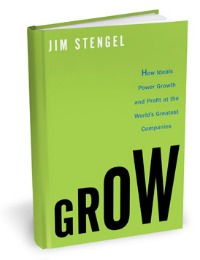By Jeff Hirsch
A fascinating new book, Grow: How Ideals Power Growth and Profit at the World’s Greatest Companies, identifies 50 brands that have outperformed competition over time. You can read an excerpt in the December 26, 2011 issue of Fortune. Written by Jim Stengel, the former head of advertising for Procter & Gamble, this piece “shows how brands with ideals (like delivering unrelentingly high-quality whiskey) are more recognizable — and profitable — in the long run.”
I couldn’t agree more, and I am grateful for empirical validation for our long-held concept of “Brand Myth.”
Brand Myths are the unique creation stories possessed by all great brands. They penetrate the psyches of consumers, mingling and ultimately melding with the consumer’s personal myths, stories and self-perceptions. The phenomenon can occur on many levels, from the stories and symbols that Carl Jung believed are “hard wired” into the brains of all human beings to the “back stories” of brands that have defined cultures and lifestyles.
In one sense, we could argue that the Golden Arches of McDonald’s connect with consumers on an unconscious level, evoking the arches of victory constructed by the ancient Greeks. But let’s get our feet on the ground here. The “back stories” of brands are what provide foundation for down-to-earth Brand Myths:
- A track coach in Oregon is inspired by a waffle iron to create a new running shoe for a world-class athlete. Nike goes on to dominate the market for athletic shoes, seeing to it in the process that kids opt for relatively expensive fashion statements over cheap sneakers.
- An appliance salesman attends a trade show in Milan where he stumbles on to the community of the Italian coffeehouse. Envisioning a “third place” between work and home, Howard Schultz creates Starbucks, as we know it today.
- Or, as Stengel’s book describes, the passion, dedication and family values of a man named Jack Daniels blossoms into the most iconic spirits brand of all time.
What most Brand Myths have in common is that they tend to be “Creation Stories” or “Hero’s Journeys” (as Joseph Campbell would call them) that reflect the vision and passion of an individual. This is where things get complicated for contemporary marketers in established companies.
Is there a place for personal vision in political, bureaucratic organizations where “long-term” can now mean next month? Jack Daniels, Nike athletic shoes, and Starbucks most likely would have never made it out of the focus group stage, had they even reached that point.
I’d sure like to think visionaries can still emerge from corporate settings. Unfortunately, change is always difficult, and there is nothing more uncomfortable than innovation. This seems to be especially true in today’s economic downturn where playing defense trumps an aggressive offense.
But the lessons of history are there should we choose to pay attention. As pointed out in the Stengel book:
“When other companies would pull back from advertising, Jack Daniel’s advertised more…Like other top businesses I’ve studied in depth, Jack Daniel’s has a “brand ideal” that is authentic to its heritage; enthusiasm for that ideal will likely resonate wherever a company takes its business.”




